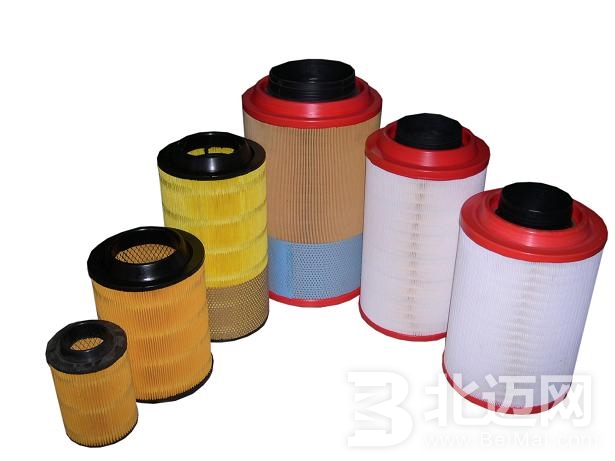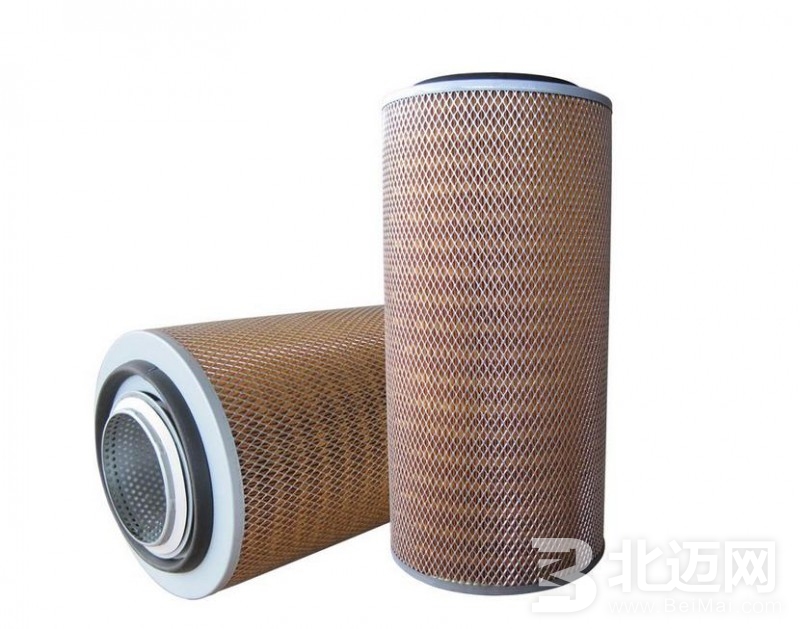There are many kinds of filters for cars. Different filters are used differently. The principle is different and the service life is different. The following are some of the types and working principles of filters for the riders. I hope that the riders can enrich the relevant knowledge in this area.

First, the type of filter:
The engine has three kinds of filters: air, oil and fuel, which are generally called "three filters". They are responsible for the filtration of the medium in the engine intake system, lubrication system and combustion system.
1, air filter
The air filter is located in the engine intake system and is an assembly of one or more clean air filter components. Its main function is to filter out harmful impurities in the air that will enter the cylinder to reduce the early wear of cylinders, pistons, piston rings, valves and valve seats. There are two types of air filters, dry and wet.
A dry air filter is a filter that separates airborne impurities through a dry filter element, such as a paper filter. Air filters used in light vehicles (including cars and mini-cars) are generally single-stage. Its shape is oblate or elliptical and flat. The filter material is filter paper or nonwoven fabric. The filter end cap is made of metal or polyurethane and the outer casing is made of metal or plastic. At the rated air volume flow rate, the original filtration efficiency of the filter element should be no less than 99.5%. Due to the harsh working environment, heavy-duty vehicles must have a large number of air filters. The grade is a cyclone prefilter (such as blade ring, swirl tube, etc.), used to filter out coarse particle impurities, the filtration efficiency is above 80%, and the second stage fine filter is a microporous paper filter (generally called main filter) The filtration efficiency is over 99.5%. There is also a safety filter element behind the main filter element to prevent dust from entering the engine when the main filter element is installed and replaced, or when the main filter element is accidentally damaged. The material of the safety core is mostly non-woven fabric, and also uses filter paper.
Wet air filters include oil immersion and oil bath. The oil immersion type is to separate the impurities in the air through an oil-impregnated filter element. The filter element material has a metal wire fabric and a foaming material. The oil bath type introduces the sucked dusty air into the oil pool to remove most of the dust, and then further filters the oil misted air through a filter element wound by the wire, the oil droplets and the stopped oil. The dust returns to the oil pool together. Oil bath air filters are now commonly used in agricultural machinery and marine power.
2, oil filter
The oil filter is located in the engine lubrication system. Its upstream is the oil pump, and downstream is the parts of the engine that need lubrication. The function is to filter harmful impurities in the oil from the oil sump, and supply the lubricating oil to the motion pair such as the crankshaft, the connecting rod, the camshaft, the supercharger and the piston ring to play the role of lubrication, cooling and cleaning. To extend the life of these components, the oil filter is divided into a removable, spin-on, and centrifugal type according to the structure; it can be divided into full-flow and split-flow according to the arrangement in the system. The filter materials used in the oil filter are filter paper, felt, metal mesh, nonwoven fabric, and the like.
Before the 1980s, the oil filters used in the national engines were mostly interchangeable. The filter of this structure is to put the filter element and other parts, such as a spring, a sealing ring and the like into a metal casing, and connect the casing filter element and the like to a metal filter seat through a tie rod. It has the advantage of low cost of use and only requires regular maintenance and replacement of the filter element. The shortcoming is that there are too many sealing points, and the maintenance and replacement of the filter element may leak parts, which is easy to cause loopholes, and the replacement is troublesome.
Since the early 1980s, the èšŒåŸ filter plant has been the first in China to introduce a spin-on filter production line from Italy. The spin-on filter has been gradually approved for domestic OEMs. The filter is characterized by a check valve, a bypass valve and only one sealing point, which is completely replaced, which greatly improves the sealing property and is easy to replace. The filter material is mostly imported filter paper, so the filtering efficiency is high. The flow resistance is small and the life is long. All domestic cars use this type of oil filter. Most of the mini-cars, as well as large, medium and small passenger cars, light and medium-duty trucks, and some heavy-duty trucks and agricultural vehicles, use spin-on oil. Filter.
The centrifugal oil filter has a rotor sleeved on a shaft and has two nozzles with opposite spray directions. When the oil enters the rotor and exits the nozzle, the rotor rotates rapidly, so that the oil in the rotor body is cleaned. The impurities in the oil are centrifuged onto the inner wall of the rotor, and the oil from the nozzle flows back to the oil sump. The centrifugal oil filter is characterized by stable performance, structure*, and no filter element to be replaced. As long as the rotor is periodically disassembled, the dirt deposited on the rotor wall can be cleaned and reused. Its life can be equal to the engine. Its shortcomings are complex structure, high price, heavy weight, etc., which have high technical requirements for users.
The full-flow oil filter, as described above, can be replaced, spin-on, split-centrifugal, etc., to filter all the oil entering the system. The split filter filters only 5%-10% of the oil from the oil pump. Split-type oil filters are fine filters, which are generally used in conjunction with full flow. Most of the low-power engines use full-flow filters, and the larger-capacity diesel engines use full-flow and split-flow filtration devices.
3, fuel filter
The fuel filter has three types of diesel filters, gasoline filters and natural gas filters. Its function is to filter out harmful particles and moisture in the engine fuel gas system to protect the oil pump nozzle, cylinder liner, piston ring, etc., to reduce wear and avoid clogging.
The structure of the diesel filter is roughly the same as that of the oil filter, and it is available in both exchangeable and spin-on versions. However, the working pressure and oil temperature requirements are much lower than that of the oil filter, and the filtration efficiency requirements are much higher than the oil filter. The filter element of the diesel filter is mostly made of filter paper, and it is also made of felt or polymer material. In addition to filtering mechanical impurities in diesel fuel, diesel filters have an important function to filter water. The presence of water is extremely harmful to the diesel fuel supply system, and rust, wear, jamming and even worsening the combustion process of diesel. The water removal mode of the diesel filtration system is mainly precipitation. Either set a precipitation chamber in the lower part of the filter or use a special precipitator. Whether it is the sedimentation chamber in the lower part of the filter or the special precipitator, there is a drain valve that opens the valve when the water accumulates to a certain amount.
The fuel filter has a carburetor type and an electric spray type. The gasoline engine of the carburetor is used. The gasoline filter is located at the inlet side of the oil pump, and the working pressure is small. Generally, the nylon casing is used, and the electrospray engine is used. The fuel filter is located on the outlet side of the oil pump and has a high working pressure, usually in a metal casing. The filter element of the gasoline filter is mostly made of filter paper, and also uses nylon cloth or polymer material.

Second, the working principle of fuel filter
The fuel filter is connected in series between the oil pump and the inlet of the throttle body. The function of the fuel filter is to remove solid impurities such as iron oxide and dust contained in the fuel to prevent the fuel system from being clogged (especially the injector). Reduce mechanical wear, ensure stable engine operation and improve reliability. The structure of the oil burner is composed of an aluminum shell and a bracket with a stainless steel inside. The bracket is provided with a high-efficiency filter paper sheet, and the filter paper sheet is formed in a chrysanthemum shape to increase the flow area. The EFI filter cannot be used with a carburetor filter. Because the EFI filter is often subjected to a fuel pressure of 200-300 KPA, the filter's compressive strength is generally required to be above 500 KPA, and the carburetor filter does not have to reach such a high pressure.

The above is some of the types of filters and working principles that Xiaobian has compiled for the riders. I hope that the riders will know more about this in their daily life.
PTFE Conveyor Belt are made from lightweight tear-resistant woven fiberglass fabrics or Kevlar fabrics coated with ptfe resin.PTFE Conveyor Belt are ideal In use in the food & food process industries(tortilla belt), in microwave, radio frequency, ultra violet, infra-red and cooling applications.Our design engineers will recommend the most suitable belt for your application and advise on ways to optimise its performance.
We have two types of these conveyor belts:
- Solid PTFE Conveyor Belt
- Mesh PTFE Conveyor Belt
Ptfe Fusing Machine Belt, Ptfe Conveyor Belt, Teflon Conveyor Belt, Fusing Machine Belt, Tortilla Belt,PTFE Belt
Jiangsu Zobon Conveyor Belt Co.,Limited , https://www.china-ptfefabric.com